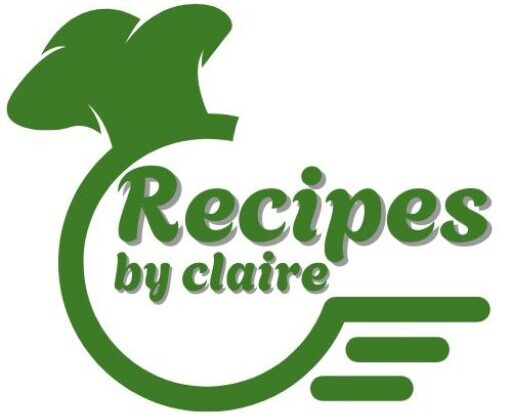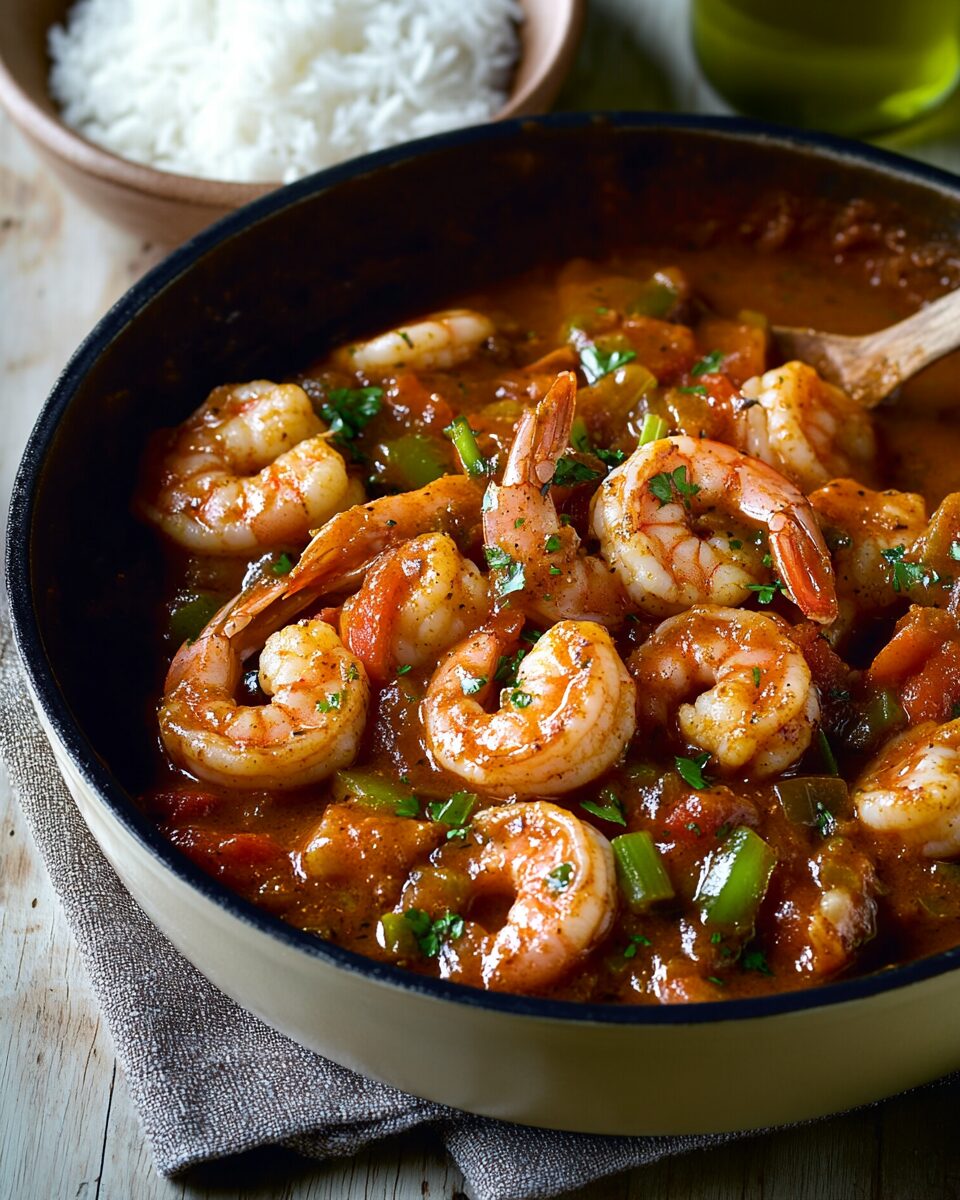The Shrimp Creole is a southern classic brimming with juicy shrimp, the “Holy Trinity” of Cajun cuisine (onion, bell pepper, and celery), and a deeply flavorful tomato-based sauce with just the right kick. Served over white rice, it’s a hearty dish that embodies bold Louisiana spirit in every bite. This dish is perfect for those craving authentic Southern flair with minimal fuss. Whether it’s a cozy weeknight dinner or a special gathering, this Shrimp Creole delivers big flavor with simple ingredients. It’s customizable to your preferred spice level, and leftovers taste even better the next day!
Full Recipe:
Ingredients:
-
1 1/2 pounds large shrimp, peeled and deveined
-
2 tablespoons olive oil
-
1 medium onion, chopped
-
1 green bell pepper, chopped
-
2 celery ribs, chopped
-
3 cloves garlic, minced
-
1 (14.5-ounce) can diced tomatoes with juice
-
1/2 cup tomato sauce
-
1/4 cup dry white wine (optional)
-
2 teaspoons Cajun seasoning
-
1/2 teaspoon dried thyme
-
1/4 teaspoon cayenne pepper (optional)
-
1 bay leaf
-
Salt and black pepper to taste
-
1 tablespoon Worcestershire sauce
-
2 green onions, chopped
-
2 tablespoons fresh parsley, chopped
-
Hot cooked white rice, for serving
Directions:
-
Heat olive oil in a large skillet over medium heat. Add the onion, bell pepper, and celery. Sauté for 5–7 minutes until softened.
-
Stir in the garlic and cook for another 30 seconds.
-
Add the diced tomatoes with their juice, tomato sauce, white wine (if using), Cajun seasoning, thyme, cayenne pepper, bay leaf, salt, black pepper, and Worcestershire sauce. Stir well to combine.
-
Reduce heat to low and simmer uncovered for 25–30 minutes, stirring occasionally, until the sauce thickens.
-
Add the shrimp and cook for 5–6 minutes, or just until the shrimp turn pink and are cooked through.
-
Discard the bay leaf. Stir in green onions and parsley.
-
Serve hot over a bed of white rice.
Prep Time: 15 minutes | Cooking Time: 35 minutes | Total Time: 50 minutes
Kcal: 280 kcal | Servings: 4 servings
Discovering Shrimp Creole: A Southern Classic with Rich Heritage and Bold Flavor
When it comes to iconic Southern dishes that embody both comfort and culture, Shrimp Creole easily takes center stage. This flavorful recipe combines the briny sweetness of Gulf shrimp with a bold tomato-based sauce infused with the aromatic “Holy Trinity” of Southern cooking: onion, bell pepper, and celery. Its deep roots in Louisiana Creole cuisine give this dish a fascinating background and a complexity that makes it beloved by generations of cooks and food lovers alike.
Whether you’re new to Southern fare or a seasoned cook looking to add another classic to your repertoire, Shrimp Creole is a must-try. It offers a delicious balance between spicy and savory, fresh and hearty all in one deeply satisfying meal. In this article, we’ll explore what makes Shrimp Creole special, how it’s different from similar dishes, cooking tips to ensure success, and the best ways to serve and enjoy it.
What Is Shrimp Creole?
Shrimp Creole is a traditional Louisiana dish that features shrimp simmered in a robust tomato sauce, often served over white rice. The sauce typically includes the region’s famed “Holy Trinity” onion, bell pepper, and celery along with garlic, tomatoes, spices, and herbs. Unlike some other Southern shrimp dishes, such as Étouffée, Shrimp Creole has a thinner, more stew-like consistency and a brighter flavor profile, thanks to its tomato base.
Although it’s a hearty, comforting dish, Shrimp Creole is surprisingly light and vibrant. The natural sweetness of the shrimp pairs beautifully with the tangy tomato sauce, while spices like cayenne pepper and paprika add depth and warmth without overwhelming the palate.
The Origins and Cultural Roots of Shrimp Creole
To truly appreciate Shrimp Creole, it helps to understand its cultural backdrop. The dish hails from Louisiana and is a shining example of Creole cuisine, a culinary tradition born from the melting pot of French, Spanish, African, Caribbean, and Native American influences in the region.
Creole food differs from Cajun cuisine, even though the two are often mistakenly used interchangeably. Where Cajun is typically rustic, born of rural traditions, Creole cuisine is more refined, urban, and influenced by classical European techniques. This is evident in Shrimp Creole’s use of tomatoes a hallmark of Creole cooking that sets it apart from many Cajun dishes.
Historically, Shrimp Creole was a dish enjoyed in the bustling port cities of Louisiana, particularly New Orleans, where fresh shrimp from the Gulf were readily available. It remains a treasured recipe, passed down through generations and adapted with regional twists and modern conveniences.
Flavor Profile and Texture
The flavor of Shrimp Creole is a delicate dance between savory and spicy, sweet and acidic. The tomato sauce, simmered until thick and rich, provides the foundation. Within it, the sweetness of bell peppers and onions balances the slight bitterness of celery, while garlic and Worcestershire sauce deepen the umami notes.
Spices such as cayenne pepper and paprika offer a subtle heat that can be adjusted based on your taste. Some versions also include a splash of white wine or lemon juice to brighten the dish, while fresh parsley and green onions bring freshness to the finish.
Texture-wise, the shrimp should be tender and just-cooked, never rubbery or overdone. The sauce should be smooth and well-balanced not too thick like a gravy, but not watery either. When ladled over fluffy white rice, each bite offers a satisfying blend of texture and flavor.
How Shrimp Creole Differs from Similar Dishes
At first glance, Shrimp Creole might seem similar to other Southern and Cajun shrimp dishes, but there are distinct differences:
-
Shrimp Étouffée: This dish has a thicker, roux-based gravy and often omits tomatoes altogether. It leans more toward Cajun style and has a creamier, more buttery base.
-
Shrimp Gumbo: Gumbo includes a dark roux and a broader mix of ingredients, often including sausage or okra. It’s also soupier than Shrimp Creole.
-
Shrimp Fra Diavolo: An Italian-American dish with a spicy tomato sauce, usually served with pasta instead of rice and seasoned with Mediterranean herbs.
Shrimp Creole is defined by its tomato-forward, tangy-sweet base and straightforward spice blend, making it accessible yet deeply flavorful.
Cooking Tips for the Best Shrimp Creole
If you’re preparing Shrimp Creole at home, here are a few tips to make sure it comes out restaurant-quality every time:
1. Use Fresh or High-Quality Frozen Shrimp
Look for wild-caught Gulf shrimp if possible. If you’re using frozen shrimp, thaw them properly in cold water and dry them before cooking to avoid a watery sauce.
2. Don’t Overcook the Shrimp
Shrimp cook quickly typically 4 to 6 minutes depending on their size. Add them toward the end of cooking and remove the dish from heat as soon as they turn pink and opaque.
3. Let the Sauce Simmer
Simmering allows the flavors to meld and the tomatoes to concentrate. Aim for at least 25–30 minutes before adding the shrimp.
4. Customize the Heat Level
Adjust the amount of cayenne or use hot sauce if you like more of a kick. For a milder dish, reduce the spice and rely more on paprika for warmth.
5. Serve Immediately
Shrimp Creole is best served fresh. However, the sauce can be made ahead and reheated—just add the shrimp when ready to serve to avoid overcooking.
Perfect Pairings and Serving Suggestions
Shrimp Creole is traditionally served over plain white rice, which helps absorb the flavorful sauce. For a twist, you could try brown rice or even cauliflower rice for a lighter option.
As for side dishes, here are a few Southern-inspired favorites that complement Shrimp Creole beautifully:
-
Cornbread or French Bread – great for sopping up the sauce
-
Collard Greens – for a bitter contrast to the sweet tomatoes
-
Fried Okra – adds crunch and Southern flair
-
Garden Salad with a Tangy Vinaigrette – balances the dish with freshness
Pair it with a cold beer, a glass of crisp white wine (like Sauvignon Blanc or Pinot Grigio), or a classic Southern iced tea for a complete experience.
Dietary Adaptations and Substitutions
Shrimp Creole is a naturally low-fat and gluten-free meal, making it suitable for many dietary preferences. You can easily adapt the recipe to fit specific needs:
-
Low-Sodium: Use no-salt-added canned tomatoes and control added salt
-
Spice-Sensitive: Reduce cayenne or omit it altogether
-
Vegetarian/Vegan: Substitute shrimp with chickpeas or sautéed mushrooms
-
Keto-Friendly: Serve over cauliflower rice or steamed vegetables
This flexibility makes Shrimp Creole not only traditional but also versatile for modern households.
Why Shrimp Creole Deserves a Spot in Your Weekly Rotation
In a world of quick-fix meals and takeout, Shrimp Creole offers a flavorful, satisfying alternative that doesn’t require excessive prep or exotic ingredients. It comes together in under an hour, uses mostly pantry staples, and brings a burst of Southern flavor that makes any dinner feel special.
More than just a dish, it’s a story in a bowl a narrative of heritage, flavor, and tradition that has stood the test of time. From humble beginnings in the port cities of Louisiana to kitchens around the world, Shrimp Creole continues to win hearts and taste buds.
Conclusion:
Shrimp Creole is more than just a Southern comfort food; it’s a cultural staple that embodies the essence of Creole cuisine vibrant, soulful, and bursting with flavor. Whether you’re cooking it for the first time or it’s a long-time favorite, this dish offers something for everyone. Its adaptability, relatively quick preparation, and crowd-pleasing taste make it an excellent choice for family dinners, casual get-togethers, or even a solo night of indulgence.
So next time you’re craving something hearty, flavorful, and rich in tradition, look no further than Shrimp Creole. With a little care and a lot of flavor, you’ll have a dish worthy of both your kitchen table and your blog readers’ appetites.






